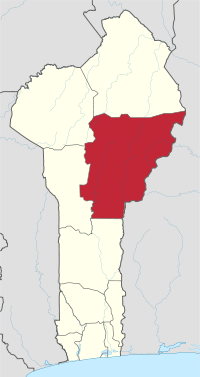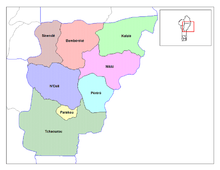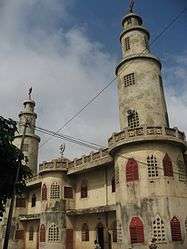Borgou Department
| Borgou | |
|---|---|
| Department | |
|
Parakou Mosque | |
 Map highlighting the Borgou Department | |
| Coordinates: 9°21′N 2°37′E / 9.350°N 2.617°ECoordinates: 9°21′N 2°37′E / 9.350°N 2.617°E | |
| Country |
|
| Capital | Parakou |
| Area[1] | |
| • Total | 25,856 km2 (9,983 sq mi) |
| Population (2013 census) | |
| • Total | 1,202,095 |
| • Density | 46/km2 (120/sq mi) |
| Time zone | WAT (UTC+1) |
Borgou is one of the twelve departments of Benin. Borgou borders the country of Nigeria and the departments of Alibori, Atakora, Collines and Donga. The capital of Borgou is Parakou. The département of Borgou was bifurcated in 1999 with its northern territory moved to the newly created Alibori Department.
Per 2013 census, the total population of the department was 1,214,249 with 607,013 males and 607,236 females. The proportion of women was 50.00 per cent. The total rural population was 56.40 percent, while the urban population was 43.60 per cent. The total labour force in the department was 271,652 out of which 25.20 per cent were women. The proportion of households with no level of education was 64.30
Geography

The department is bounded by Atkora Mountains in the west, Niger river in the north and regions of Mali to the south. Geographically, the Borgou region is split among Benin and Nigeria, with 130,000 sq. km in Benin and 52,000 sq.km in Nigeria.[2] The northeast region is fertile with highland and savannah. Cotton, corn and cassava are the major crops in the country.[3] The northeast plains slope down to the valleys of Niger river. The climate is usually humid and tropical. The nothern regions of Benin, in general, receive one season of rainfall from May to September, compared to the southern regions which receive two spells from March to July and September to November.[4] The average maximum temperature in the department is experienced from April to June when it reaches 40 °C (104 °F), while the average minimum temperature between 12 °C (54 °F) to 25 °C (77 °F) is observed during November to March. The average elevation of the department is 200 m (660 ft) above the mean sea level.[5]
Demographics
Per 2013 census, the total population of the department was 1,214,249 with 607,013 males and 607,236 females. The proportion of women was 50.00 per cent. The total rural population was 56.40 percent, while the urban population was 43.60 per cent. The proportion of women in child bearing age of 15 to 49 years was 22.30 per cent. The total foreign population in the department was 22,665 which formed 1.90 per cent of the total population in the department. The propotion of assets of foreigners aged 10+ years was 30.80 per cent, while for the people aged 15-64 years, it was 30.20 per cent. The proportion of women in foreign population constituted 47.00 per cent. The number of households in the department was 158,099 and the average household size was 7.7. The intercensal growth rate of population was 4.70 per cent.[7]
The average age of women during first marriage in the department was 27.1 and the average age at maternity was BORGOU. The synthetic index of fertility of women was 5.4. The average number of kernels in a house was 1.7 and the average number of persons in a room was 1.8. The total labour force in the department was 271,652 out of which 25.20 per cent were women. The proportion of households with no level of education was 64.30 and the proportion of households with children attending school was 47.10. The crude birth rate was 39.5, general rate of fertility was 176.90 and the gross reproduction rate was 2.70.[6]
Administrative divisions

Borgou is subdivided into eight communes, each centered at one of the principal towns, namely, Bembèrèkè, Kalalé, N’Dali,* Nikki, Parakou, Pèrèrè, Sinendé and Tchaourou. The département of Borgou was bifurcated in 1999 with its northern territory moved to the newly created Alibori Department.[8] Benin, formerly known as Dahomey, was a French colony till 1894. It gained independence during 1960 and was admitted to the United Nations. From 1960 to 1972, there was political instability with frequent change of leadership.[9] Benin originally had six administrative divisions, but was further bifurcated to make it 12. Each de-concentrated administrative services, called directions départementales(DD) of the sectoral ministries, take care of two administrative regions. A law passed during 1999 empowered the territorial administration to local governments.[8] Municipalities and communal councils have elected representatives who manage the administration of the regions. The latest elections of the municipal and communal councils were held during June 2015.[10] The funds were disbursed once during 2002 from Ministry of Interior Affairs to the communes, but the rules and budgeting were not clarified.[8]
References
- ↑ "Benin". Geohive. Retrieved 25 November 2016.
- ↑ Houngnikpo, Mathurin C.; Decalo, Samuel (2013). Historical Dictionary of Benin. Rowman & Littlefield. ISBN 9780810871717.
- ↑ McColl, R. W. (2014). Encyclopedia of World Geography, Volume 1. Infobase Publishing. p. 92-93. ISBN 9780816072293.
- ↑ Haggett, Peter, ed. (2002). Encyclopedia of World Geography, Volume 17. Marshall Cavendish. p. 2325. ISBN 9780761473060.
- ↑ Idelbert, Dagbegnon (2014). Flood Disaster and Human Security in Bénin Niger River Valley. Behanzin. p. 11.
- 1 2 "Socio economic data of Benin, 2013". Institut National de la Statistique et de l’Analyse Economique (INSAE) du Benin. 2013. Retrieved 25 November 2016.
- ↑ "Census of Benin, 2013". Institut National de la Statistique et de l’Analyse Economique (INSAE) du Benin. 2013. Retrieved 25 November 2016.
- 1 2 3 Republic of Benin, Public Administration and Country profile (PDF) (Report). Department of Economic and Social Affairs (DESA), United Nations. 2004. p. 8. Retrieved 17 November 2016.
- ↑ "Benin country profile". BBC. 5 August 2016. Retrieved 20 November 2016.
- ↑ "Local elections in Benin, 2015". African Elections Database. Retrieved 25 November 2016.
